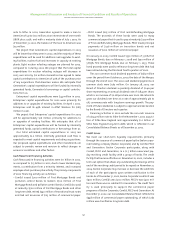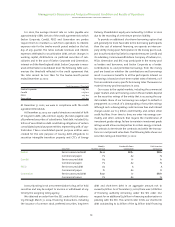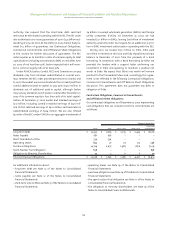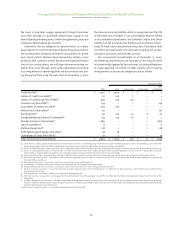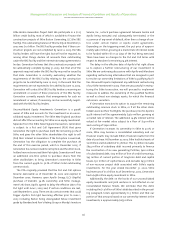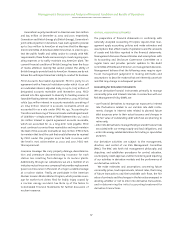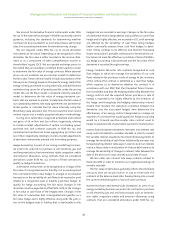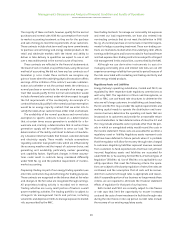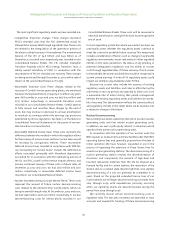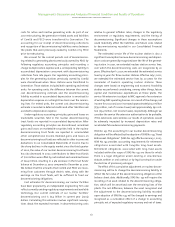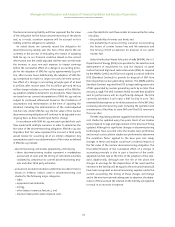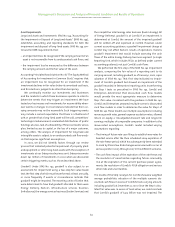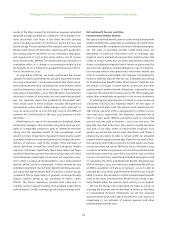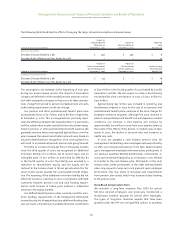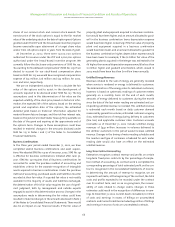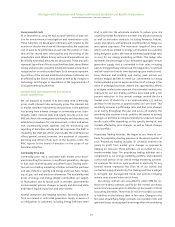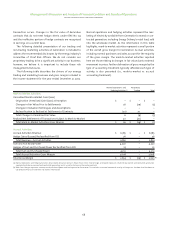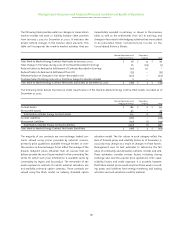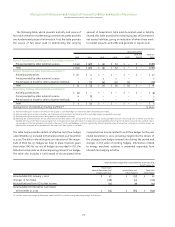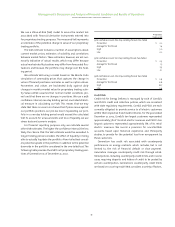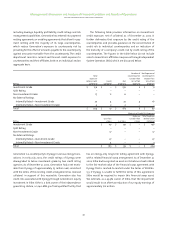ComEd 2002 Annual Report Download - page 64
Download and view the complete annual report
Please find page 64 of the 2002 ComEd annual report below. You can navigate through the pages in the report by either clicking on the pages listed below, or by using the keyword search tool below to find specific information within the annual report.
62
The decommissioning liability will then represent the fair value
of the obligation for the future decommissioning of the plants
and, as a result, accretion expense will be accrued on this
liability until the obligation is satisfied.
As noted above, we currently record the obligation for
decommissioning ratably over the lives of the plants. We are
currently in the process of evaluating the impact of adopting
SFAS No. 143 on our financial condition. Based on the current
information and the credit-adjusted risk-free rate, we estimate
the increase in 2003 non-cash expense to impact earnings
before the cumulative effect of a change in accounting princi-
ple for the adoption of SFAS No. 143 by approximately $24 mil-
lion, after income taxes. Additionally, the adoption of SFAS No.
143 is expected to result in a large, non-cash,one-time cumula-
tive effect of a change in accounting principle gain of at least
$1.5 billion, after income taxes.The $1.5 billion gain and the $24
million charge includes our share of the impact of the SFAS No.
143 adoption related to AmerGen’s nuclear plants.These impacts
are based on our current interpretation of SFAS No. 143 and are
subject to continued refinement based on the finalization of
assumptions and interpretation at the time of adopting the
standard, including the determination of the credit-adjusted
risk-free rate. Under SFAS No. 143, the fair value of the nuclear
decommissioning obligation will continue to be adjusted on an
ongoing basis as these model input factors change.
In accordance with SFAS No.143,we used a probabilistic cash
flow model with multiple scenarios in order to determine the
fair value of the decommissioning obligation. SFAS No. 143 also
stipulates that fair value represent the amount a third party
would receive for assuming all of an entity’s obligation. Key
assumptions used in our determination of fair value as defined
in SFAS No.143 include:
– decommissioning cost studies prepared by a third party
– these decommissioning studies represent a marketplace
assessment of costs and the timing of retirement activities
validated by comparison to current decommissioning proj-
ects and other third party estimates
– annual cost escalation studies to determine escalation factors
based on inflation indices used in decommissioning cost
studies for the following major categories:
– labor,
– equipment and materials,
– energy,
– other (taxes,insurance, fees,etc.), and
– low-level radioactive waste disposal costs.
– use of probabilistic cash flow models to measure the fair value
including:
– the probability of various cost levels, and
– the probability of various timing scenarios incorporating
the factors of current license lives and life extension and
the timing of DOE acceptance for disposal of our spent
nuclear fuel.
Under the Nuclear Waste Policy Act of 1982 (NWPA), the U.S.
Department of Energy (DOE) is responsible for the selection and
development of repositories for, and the disposal of, spent
nuclear fuel and high-level radioactive waste (SNF). As required
by the NWPA, ComEd and PECO each signed a contract with the
DOE (Standard Contract) to provide for disposal of SNF from
their respective nuclear generating stations.The NWPA and the
Standard Contract required the DOE to begin taking possession
of SNF generated by nuclear generating units by no later than
January 31,1998.The DOE, however,failed to meet that deadline
and its performance will be significantly delayed. The DOE
currently estimates it will open a SNF facility in 2010. This
extended delay requires us to retain possession of the SNF, thus
increasing decommissioning costs including the operation and
maintenance of facilities to store SNF until the DOE removes it
from our sites.
The NRC regulatory guidance suggests that decommissioning
cost studies be updated every five years. Most of our studies
were prepared in 1995 and 1996 and are in the process of being
updated. Although no significant changes in decommissioning
technologies have occurred since the studies were performed,
and annual cost escalation studies are performed to determine
the escalation factor applied to the base year cost study,
changes in these cost studies could have a material impact on
the fair value of the nuclear decommissioning obligation. The
final determination of the cumulative effect of a change in
accounting principle is also in part a function of the credit-
adjusted risk-free rate at the time of the adoption of the stan-
dard. Additionally, although over the life of the plant, the
charges to earnings for the depreciation of the asset and the
interest on the liability will be equal to the amounts that would
have been recognized as decommissioning expense under the
current accounting, the timing of those charges will change
and in the near-term period subsequent to adoption,the depre-
ciation of the asset and the interest on the liability are expected
to result in an increase in expense.
Management’s Discussion and Analysis of Financial Condition and Results of Operations
exelon corporation and subsidiary companies


